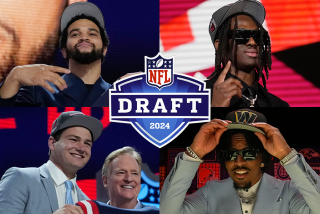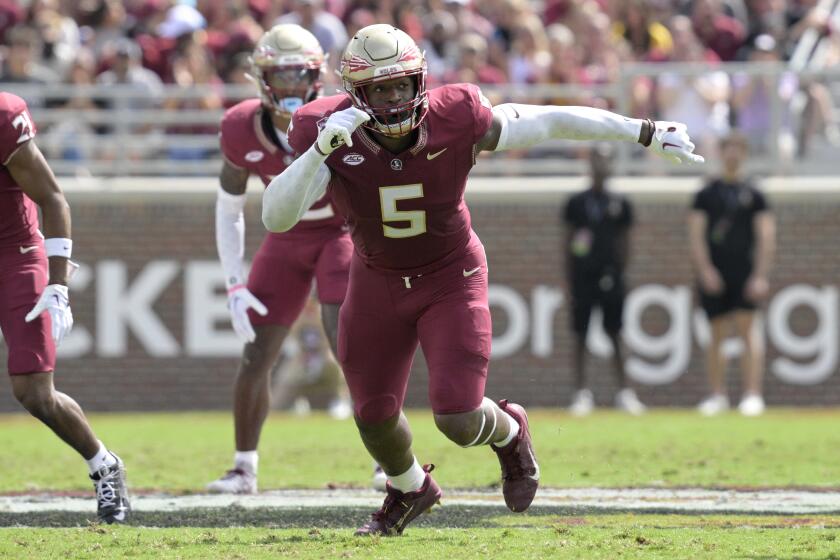Sports league channels play a dangerous game
Tonight’s Chicago Bears-San Francisco 49ers game won’t decide a championship, and millions of Americans won’t even be able to see the game at home. But no matter who wins on the field, the broadcast will likely score a ratings touchdown for the NFL Network -- and spark some chatter in the sports TV industry.
And the big water-cooler topic is this: How can league-owned outlets such as the NFL Network strike a balance between complementing and cannibalizing their media partners? Leagues “have to be aware of -- and careful not to kill -- their golden goose,” said Neal Pilson, the former president of CBS Sports who now runs a sports-media consulting firm in Chappaqua, N.Y. “What is the endgame?”
The modern, multi-billion-dollar global sports industry has been built, to a large degree, on the massive sums that networks pay for the TV rights of high-profile leagues and teams. The NFL alone will net more than $20 billion over the next five years from its current deals with ESPN, NBC, CBS, Fox and DirecTV.
But in recent years, pro sports leagues have morphed into full-blown media companies, launching their own TV channels, advertising networks and digital entertainment ventures. With the debut of Major League Baseball’s MLB Network earlier this year, all four major U.S. pro sports leagues -- MLB, the NFL, the NBA, and the NHL -- now operate 24-hour cable channels.
“The channels give the leagues a chance to get their message out as they want to frame it, unadulterated,” said Pilson.
No sports league draws viewers as does the NFL, which has been enjoying a particularly good run on TV this fall. Through the first nine weeks of the 2009 season, ratings for NFL games are up 15% from 2008, with an average of 17.2 million viewers per game -- the most in 20 years, according to the league.
The numbers for prime-time games, which had been declining in recent years, have been very strong, with NBC’s ratings for Sunday night games up 22% and ESPN reporting 18% growth for “Monday Night Football.” (Last month’s Green Bay Packers-Minnesota Vikings Monday night game, which featured new Vikings quarterback Brett Favre matching up against his old Packers teammates for the first time, drew more than 22 million viewers and was the highest-rated event in cable TV history, according to Nielsen.) In contrast, ratings for the other pro sports leagues have been flat or have decreased.
Ratings for all of the league-owned channels, including the NFL Network, are still minuscule. The networks largely broadcast an endless mix of old games and studio highlight shows, but are increasingly angling to broadcast more of their leagues’ most valuable content: live games.
This season, NBA TV will air nearly 100 regular-season games, as well as several early-round playoff contests. In its debut year, MLB Network carried a package of exclusive Thursday night games and put the league’s annual draft on TV for the first time.
“League offices have an unhealthy belief that viewers, consumers and distributors want more of their product,” said one veteran cable executive, who declined to be identified because his network is in business with all of the leagues.
In 2006, as part of its negotiations for new TV deals with broadcasters, the NFL created a new slate of eight prime-time games that would be played on Thursday and Saturday nights during the second half of the season. According to industry executives, the plan was to sell the package for approximately $450 million per season to Comcast, which would air the games on its Versus channel. At the last minute, however, the negotiations stalled -- and the NFL elected to put the games on its own channel, which debuted in 2003 and is based in Culver City.
The only problem: Comcast, the nation’s No. 1 cable company, refused to pay the league $1 per subscriber or put the NFL Network on its basic cable tier, as did several other cable systems. The upshot: For the last three seasons, millions of viewers haven’t been able see NFL Network games.
The broadcasts were made available on free TV to viewers in the local markets of whatever two teams were playing in a given week, but the dispute was an embarrassment for the NFL and raised concerns among NFL owners about the league’s TV strategy. Last year, according to several veteran sports-TV executives, the NFL considered selling a portion of the NFL Network to ESPN or Fox in an effort to gain larger distribution for the league’s channel.
Earlier this year, however, the league finally ended its dispute with Comcast, in part because the NFL lowered its subscriber fee demands and gave all cable companies access to the Red Zone Channel, which gives viewers live “look-ins” to games and showcases teams that are close to scoring.
With the addition of Comcast subscribers, the NFL Network is now available in about 53 million homes -- up 26% from last year, but still a far smaller footprint than basic-cable outlets such as ESPN, TBS or even TruTV. Time Warner Cable, which is the No. 1 cable system in the L.A. area, still does not carry the NFL Network.
“We have distribution with four of the top five TV companies in the business, and they’re happy with us,” said Steve Bornstein, the NFL Network’s president and CEO, who spent more than 20 years at ESPN. “We’re doing this to serve our fans and to grow interest in our sport.”
What remains to be seen is just how far any of the leagues will go to increase the distribution -- and therefore, the value -- of their networks.
The NFL would likely have to add at least 15 million to 20 million more subscribers to create the mix of subscriber fees and advertising revenue that would make it economically feasible for the NFL to add more games to its network and forfeit rights fees from another broadcaster. Networks with fewer than 70 million subscribers are generally not considered “national buys” by advertising agencies, and therefore can’t generate premium rates for commercials.
The surest way for the NFL to generate subscriber demand, of course, would be to give its network more games in the next round of TV contracts, all of which run through 2013, with the exception of DirecTV’s deal, which goes through 2014.
“We don’t rule anything out,” said Bornstein.
--
More to Read
Get our high school sports newsletter
Prep Rally is devoted to the SoCal high school sports experience, bringing you scores, stories and a behind-the-scenes look at what makes prep sports so popular.
You may occasionally receive promotional content from the Los Angeles Times.






